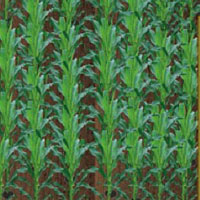Physiological and nutritional significance of potassium application under sole and intercropped maize (Zea mays L.)

Accepted: 7 January 2021
HTML: 409
All claims expressed in this article are solely those of the authors and do not necessarily represent those of their affiliated organizations, or those of the publisher, the editors and the reviewers. Any product that may be evaluated in this article or claim that may be made by its manufacturer is not guaranteed or endorsed by the publisher.
Highlights
- Potassium nutrient management in maize-soybean strip intercropping can increase the resource use efficiency.
- Compared to the T0 (no potassium), T2 (80 kg ha–1 on maize) application increases the light interception and leaf area index of maize by 17% and 38% respectively.
- Regression analysis reveals a positive relationship between physiological parameters measured at R2 and at R6 growth stages in maize under maize-soybean strip intercropping.
- High K2O (80 kg ha–1) inputs enhanced the partitioning of biomass production in maize.
- Overall, the optimum K2O application increased the maize yield by 16% under maize-soybean strip intercropping system relative to control.
Globally, maize is an essential food and fodder crop. Fertilisers, as soil amendments, particularly K2O, could increase maize yields. A Two-year field research was designed in 2018- 2019 to examine the influence of three-potassium fertiliser applications on maize-soybean strip intercropping and sole-maize yield components. A Randomized complete block design with three replications was used, and one of three K2O doses (T0, 0; T1, 40:30; T2, 80:60 kg ha–1) was given in each plot. The effects K2O treatments on photosynthetic characteristics, photosynthetic active radiation, leaf area index, total biomass accumulation, and seed yield were investigated at V6, R2, R4, and R6. Compared to T0, maize-soybean strip intercropping system and sole-maize results showed T2 maize enhanced the light interception by 14, 26, 15, and 17% at V6, R2, R4, and R6 respectively. Maize increased the partitioning of biomass to cob and seed by 8 and 10% at R6, respectively in T2, relative to T0 treatment. T2 showed a higher green leaf area than T0; K2O applications led to an enhancement in leaf area index at R6 by 38%, under T2, and subsequently increased the photosynthetic rate at R4 and R6 by 8% and 6% respectively, in both years of the study. These results suggest that we may increase the accumulation of biomass and the yield of the maize seed under maize-soybean strip intercropping system and sole-maize by optimum K application in maize plants.
How to Cite
PAGEPress has chosen to apply the Creative Commons Attribution NonCommercial 4.0 International License (CC BY-NC 4.0) to all manuscripts to be published.

 https://doi.org/10.4081/ija.2021.1737
https://doi.org/10.4081/ija.2021.1737



